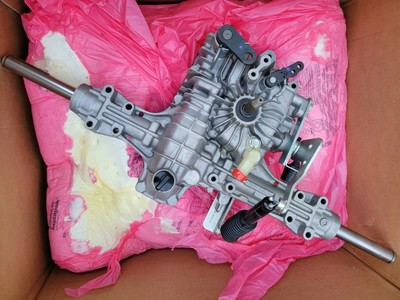First time, long time ....
I have a 2014 John Deere X320 tractor with a Tuff Torq K58 transmission installed. It has about 405 hours of operation. I mow about 1.5 acres of which 0.1 acre is a 17% hill (which I do half downhill and half uphill).
Last summer, for the first time, the transmission in my tractor started overheating after a few passes up that hill (it usually takes about 8 passes up the hill to mow it). I’d let it sit for a while to cool off, and then I’d do a little more. This spring, I changed out the transmission fluid as was recommended by Tuff Torq and also seeing the same recommendation in this forum. Unfortunately, that did not help the situation so now I find myself considering replacing the transmission (I’m not mechanical enough for a rebuild).
My previous tractor was a Toro 267H. I looked that up and it had a Tuff Torq K61 transmission which, interestingly enough, has the same rated torque as my current K58. The Toro lasted at least 15 years on the same hill with no problem, so I'm wondering if my current transmission is a lemon and I should just get a new K58 (now with periodic transmission fluid changes!) or should I upgrade to a K66 transmission for which I see kits available online.
Does anyone have experience replacing the K58 with a K66? Any advice or things I should look for? In particular, I’m worried about the axle bolt holes lining up, whether the splines on the axle are the same, and whether or not the existing transmission drive belt for the K58 could be reused for the K66.
Also, after I got the transmission exposed to allow me to change out the fluid, I thought I’d go further and remove it from the tractor to turn it upside down for a complete drain. However, when I removed the spring pin that holds the tractor brake rod, I couldn’t push the brake rod up to get it out of the brake lever on the transmission. Is there a trick for removing the tractor brake rod from the transmission?
Thanks for your help!
I have a 2014 John Deere X320 tractor with a Tuff Torq K58 transmission installed. It has about 405 hours of operation. I mow about 1.5 acres of which 0.1 acre is a 17% hill (which I do half downhill and half uphill).
Last summer, for the first time, the transmission in my tractor started overheating after a few passes up that hill (it usually takes about 8 passes up the hill to mow it). I’d let it sit for a while to cool off, and then I’d do a little more. This spring, I changed out the transmission fluid as was recommended by Tuff Torq and also seeing the same recommendation in this forum. Unfortunately, that did not help the situation so now I find myself considering replacing the transmission (I’m not mechanical enough for a rebuild).
My previous tractor was a Toro 267H. I looked that up and it had a Tuff Torq K61 transmission which, interestingly enough, has the same rated torque as my current K58. The Toro lasted at least 15 years on the same hill with no problem, so I'm wondering if my current transmission is a lemon and I should just get a new K58 (now with periodic transmission fluid changes!) or should I upgrade to a K66 transmission for which I see kits available online.
Does anyone have experience replacing the K58 with a K66? Any advice or things I should look for? In particular, I’m worried about the axle bolt holes lining up, whether the splines on the axle are the same, and whether or not the existing transmission drive belt for the K58 could be reused for the K66.
Also, after I got the transmission exposed to allow me to change out the fluid, I thought I’d go further and remove it from the tractor to turn it upside down for a complete drain. However, when I removed the spring pin that holds the tractor brake rod, I couldn’t push the brake rod up to get it out of the brake lever on the transmission. Is there a trick for removing the tractor brake rod from the transmission?
Thanks for your help!











